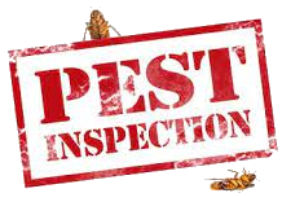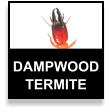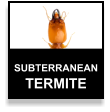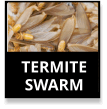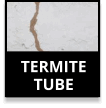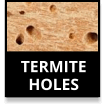Termite Control
Saint Cloud, FL
Although small, termites can cause significant damage to both the exterior and interior of a structure if left without proper treatment. If you suspect termites, consult a local Saint Cloud exterminator.
While there many types of termites, the most frequently encountered species in the region are that of the Eastern subterranean termite, the Florida drywood termite and the Florida dampwood termite. While all are destructive, they each carry their own risk.
Generally, termites reproduce quickly and can become a large colony in a short time. Experts note that for each human on the planet, there are likely close to 1,000 termites. The queen termites of a colony are considered to have the longest life expectancy of any insect. Most believe that queens live between 30 and 50 years. Termite queens are thought able to lay one egg every 15 seconds. In her long lifetime, one single queen is estimated to lay close to ten million eggs. Finding termite colonies and dealing with them quickly is important to ensure that colonies do not grow into uncontrollable populations.
WHAT DO TERMITES LOOK LIKE?
The appearance of termites differs based on the type of termite and the class of termite within the colony. Eastern subterranean termites are organized into three different classes: the workers, the soldiers and the reproductives. Worker and soldier termites are both wingless, with either cream-colored or yellow bodies. Reproductive termites have wings and are normally brown or black. They are typically larger than workers and soldiers.
Florida drywood termites are less than a half inch in size and are winged. As adults, they are often dark in color. The Florida dampwood termite is larger, often greater than half an inch. While they are most frequently brown, they can also be red in color. All termites are insects and have six legs.
HOW TERMITES GET INSIDE
Sometimes, termites will enter a home or business in order to seek food sources and escape predators. Common predators of termites include other insects, such as ants or wasps, spiders and bats. In fact, ants are known as the primary predator and competitor of termites. In their search for security, termites can enter a building through various routes. Drywood termites can gain entry through practically any dry wooden structure of a home. This commonly includes attics, where there is an abundance of dry wood. These pests can also infest furniture or other home fixtures, such as windowsills or doors. Some drywood termites can even enter a home through secondhand furniture that is already infested. An indicator of drywood termites includes small piles of sawdust near wooden structures.
Subterranean termites and their colonies can enter home through their mud tubes. While these termites live underground, they can build tunnels to connect them from the soil to building entry points. Due to their size, they only require only a very small crack to enter a building. Tiny holes or cracks in bricks and concrete can be an easy access point for termites. It is especially important for a professional to inspect and properly seal any potential areas of concern to keep termites from moving inside.
WHERE DO TERMITES LIVE?
There are termites found in most areas of the United States, but they are especially prevalent in Florida as they are attracted to warm and dry climates. Subterranean termites choose to live underground. They can live up to five feet below the surface. These termites will create mud tubes or tunnels to travel from the underground soil to their wood sources.
As their name suggests, drywood termites live in dry, or non-decayed, wood. These pests do not need to be near soil and therefore can move indoors. Inside, these termites may live in attics, within doors and even inside furniture. Dampwood termites prefer to live in wood with moisture. Typically, they will live in a decayed log or in other moistened wood outdoors.
WHAT DO TERMITES EAT?
While some believe that termites eat wood, this is not necessarily true. Termites instead eat a molecular component found within the wood. The main food source for termites is cellulose. This molecule consists of many individual glucose units and is widely found in the cell walls of plants. This includes trees and bark, such as oak trees or hardwood. Both decayed and living wood are optimal for them. This diet makes homes and office buildings the ideal place for termites to live. Crawl spaces, attics and decks all provide constant access to cellulose. This food source can also be found in carpets. Termites typically will not eat through paint, meaning that painted wood may serve as a barrier if kept in good condition.
Most termites eat all day long. They are known to out-eat any human. Because they do not have the need for sleep, termites are active throughout the entire day. Each day, one termite in a colony will normally eat two percent of its body weight in wood. With colonies reaching into the hundreds of thousands and even millions, this can cause serious damage if allowed to continue over prolonged periods.
DAMAGE CAUSED BY TERMITES
Each year, it is estimated that termites cause billions of dollars in damage. Unfortunately, existing termite damage is not typically covered by home insurance. A termite infestation can ultimately cost a home or property owner thousands of dollars in repairs.
Some termite damage is visible. Property owners may see damaged wood, including buckled or bulging areas. Over time, damaged wood can be dangerous. If wood sounds hollow when tapped, it can be a sign of a termite infestation. When wood is warped or badly damaged, it can lead to serious structural damage. This type of damage can impact the foundation of a home, crawl spaces and even ceilings. Termite damage to ceilings often appears as water damage. As these pests feast on food sources, ceilings may begin to sag. Repairs to ceilings are especially costly to repair, as they require a complete renovation of the area. Over time, infestations can also lead to a foul odor. This odd smell resembles a mold or mildew scent. The Florida drywood termite is especially threatening to buildings, as it is most likely to move indoors. Drywood termites can damage the walls, roofs, flooring and siding of a home or building.
Contrary to this, termite activity can continue undetected for long periods, becoming visible only after extensive damage is caused. The Eastern subterranean termite can create unseen mud tubes underground. The underground colonies will venture out of the soil to feast on wood within a property.
With a tendency for consuming wood from inside out, termites often go unnoticed without a professional inspection conducted by an experienced pest control provider.
HOW TO DETECT TERMITES
Signs of a termite infestation include:
- Tapping sections of wood produces a distinct hollow sound
- Tiles on floors or walls exhibit a noticeable looseness
- The presence of swarming dark-colored, airborne insects
- Drywall displays signs of drooping or unusual discoloration
- Inspection around the foundation unveils accumulations of discarded wings
- Doors and windows show signs of being difficult to open or close
- Squeaks emanate from the floorboards
- The interior of the structure reveals discoloration reminiscent of water damage
HOW TO PREVENT TERMITES
To help prevent termite issues the following steps should be taken:
- Improve ventilation in crawl spaces and basements to minimize humidity
- Arrange for annual inspections conducted by a certified exterminator
- Avoid storing firewood or lumber in close proximity to structures
- Prevent direct contact between wood and soil
- Implement proper drainage to divert water away from building foundations
HOW WE TREAT FOR TERMITES
Newtown Termite & Pest Control is a certified Termidor® exterminator. We utilize the nation's #1 termiticide when treating homes or businesses. Our technicians apply the product to the exterior of the structure. Once applied, Termidor® becomes undetectable and begins killing termites by contact and indigestion.
Independent testing conducted by the USDA detected no termite damage in concrete slab structures treated with Termidor® 80 WG for more than 15 years following the treatment.
For effective termite extermination our experienced technicians apply the Termidor along the foundation or exterior of the home or business. Once applied, the termiticide blends into the soil and is transferred to termites as they come in contact with the agent. The termiticide is also transferred among the termite colony as infected termites come in contact with other termites. Termidor kills termites both by ingestion as well as by contact.
Our termite control treatment service will terminate an existing termite infestation and protect against future occurrences.
OUR TERMITE TREATMENT WARRANTY
Homes and businesses have been trusting Newtown Termite & Pest Control, Inc. since 1993. We are a termite control provider with an A+ Accredited BBB rating. Combined, our certified, company-trained technicians have over 50 years of field experience.
Our termite control treatment service will terminate an existing termite infestation and protect against future occurrences with our renewable, transferable, triple guarantee:
- If, within one year of your first treatment, we uncover a new colony of live termites, we will retreat your home for FREE.
- If, during the first five years of your service contract, we uncover a new colony of live termites, we will retreat your home for FREE.
- If, during the first five years or any year thereafter, we uncover a new colony of live termites, we'll retreat for FREE ... EVEN IF YOU SELL THE HOME!
WHEN WAS YOUR LAST TERMITE INSPECTION?
Industry experts agree that the first step in effective termite control is to have your home or business undergo a full termite inspection at least every two to three years.
That is because termites, often referred to as the "silent destroyers" can go unnoticed until visible damage occurs.
Having your St. Cloud area home or business professionally inspected by a certified technician is the best way to help detect the presence of termites and prevent extensive damage.
Call 407-966-4054 to schedule a FREE inspection today.


